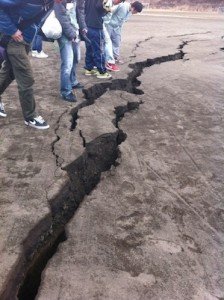Japan’s approach to earthquake analysis and prediction is flawed and outdated, according to an expert commentary published in the journal Nature.
 An Japan-based American Seismologist, Robert J. Geller, has written a commentary article in Nature which makes a scathing attack on the earthquake prediction methodologies used by Japanese experts in the years preceding the devastating march 11th quake. The ‘Tokai prediction system’ has been in place for more than 30 years and identifies hazardous area using outdated and unproven geophysical theories.
An Japan-based American Seismologist, Robert J. Geller, has written a commentary article in Nature which makes a scathing attack on the earthquake prediction methodologies used by Japanese experts in the years preceding the devastating march 11th quake. The ‘Tokai prediction system’ has been in place for more than 30 years and identifies hazardous area using outdated and unproven geophysical theories.
Nature has made the full text of the article available online.
An excerpt:
For the past 20 years or so, some seismologists in Japan have warned of the seismic and tsunami hazards to the safety of nuclear power plants, most notably Katsuhiko Ishibashi, now professor emeritus at Kobe University. Their warnings went unheeded. Yet in the immediate aftermath of the magnitude-9.1 earthquake that struck Tohoku on 11 March, pundits could be found on many Japanese TV stations saying that it was “unforeseeable”.
The ‘foreseen’ earthquakes were presumably the hypothetical future earthquakes used by the Japanese government to produce national seismic hazard maps for Japan. The modellers assume that ‘characteristic earthquakes’ exist for various zones, choose the fault parameters for each zone as the input to their model, and then produce probabilistic hazard maps.
Although such maps may seem authoritative, a model is just a model until the methods used to produce it have been verified. The regions assessed as most dangerous are the zones of three hypothetical ‘scenario earthquakes’ (Tokai, Tonankai and Nankai; see map). However, since 1979, earthquakes that caused 10 or more fatalities in Japan actually occurred in places assigned a relatively low probability. This discrepancy – the latest in a string of negative results for the characteristic earthquake model and its cousin, the seismic-gap model – strongly suggests that the hazard map and the methods used to produce it are flawed and should be discarded.
Globally, in the past 100 years, there have been five subduction-zone earthquakes of magnitude 9 or greater (Kamchatka 1952, Chile 1960, Alaska 1964, Sumatra 2004, Tohoku 2011), which suggests that the upper limit on the possible size of a subduction-zone earthquake may not much depend on the details of the subduction modality. Large tsunamis have frequently struck the Pacific coast of the Tohoku district. The well-documented 1896 Sanriku tsunami had a maximum height of 38 metres and caused more than 22,000 deaths. The 869 Jogan tsunami is documented to have had a height roughly comparable to, or perhaps slightly less than, that of the 11 March tsunami.